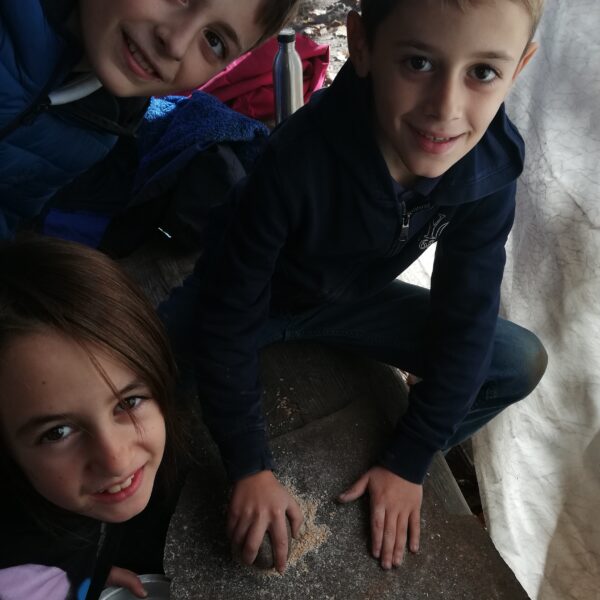
Autumn Archeoweek / Cooking in the Neolithic
During the autumn holidays 15 children between ages 8 and 12 travelled back to the Stone Age with Archeoweek. This time the program included a focus on cooking in Ötzi’s time and making ceramics. After a recent follow-up meeting last week the children were able to take home the vessels which they had made and fired in the kiln.
Based on archaeological finds in our special exhibition “PAST FOOD. 15,000 years of nutrition”, the kids learned what foods were available to people here in South Tyrol from the Stone Age to Roman times. They tried their luck at cutting an apple with flint blades, opening nuts using stones, and grinding flour using a quern-stone.
The next item on the agenda was creating various ceramic vessels from early history: here the children learned about the various shapes that people typically used during the Stone and Bronze Ages. These were vital for storing food or cooking. Stefania Titton, an archaeologist and ceramicist, introduced the kids to the process of making pottery by hand. Under her guidance they made vessels decorated in the style of the Bell Beakers, Corded Ware (campaniforme), Square-Mouthed Vases culture (vasi a bocca quadrata), and even a Venus figurine from the Paleolithic.
The children were allowed to smash the copy of a vessel in order to identify the pieces which often show up during archaeological excavations. This way they were able to understand how archaeologists reconstruct and restore a vessel from shards.
In Kohlern/Colle with beautiful autumn weather, the kids got down to business building two fireplaces with the help of archaeological and educational support staff. One fireplace was used to fire ceramics, while the other was used to prepare a Stone Age lunch: a delicious barley soup with legumes and vegetables, accompanied by homemade flatbread baked on a hot stone. The children tried to light the fire themselves, like Ötzi did with pyrite, flint, and tinder fungus.
While the soup was simmering and the ceramic vessels were firing, the children went looking for useful herbs to make a tea under the guidance of experts. They also made prints on fabric with “pintaderas,” which are ceramic shapes that had been used for decoration as far back as the Neolithic.
The beginnings of beekeeping also lie in the Neolithic period. A trip to the Bee Museum in Ritten/Renon wrapped up Archeoweek.
Photos: The children who participated in the autumn Archeoweek with educational support from Giuliana Plotegher, Stefania Titton, Nico Aldegani, and Devon Vitrugno, South Tyrol Museum of Archaeology.
(c) South Tyrol Museum of Archaeology e Stefania Titton, Nico Aldegani e Devon Vitrugno



























